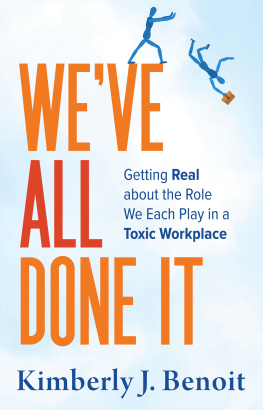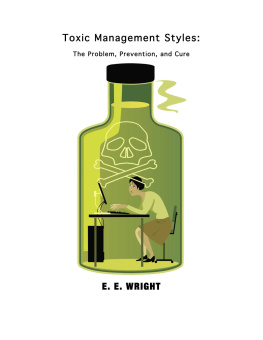Table of Contents
To all those who have suffered from the effects of toxic behaviors at work. And to the leaders who told us their stories in hope of finding paths to respectful engagement in their organizations and communities.
Toxic Workplace!
The day this person left our organization is considered an annual holiday!
Part One
Understanding Toxic People and Toxic Environments
Before you can solve a problem, you have to fully understand it. Therefore, the chapters in Part One examine in depth toxic peoplethose who do damage to their coworkers, staffs, bosses, and customers. Chapter One describes the significant organizational losses, human and financial, that these people cause. Because recognizing toxicity is not easy, Chapter Two describes the types of toxic behavior, from humiliating others to sabotaging team efforts. Chapter Three identifies strategies that dont work in dealing with toxic people so you wont waste your time on these! And Chapter Four shows how toxicity spreads like an infection in organizations.
THE HUMAN AND FINANCIAL COSTS OF WORKING WITH TOXIC PEOPLE
Toxic Behaviors Are Just the Tip of the Iceberg
Working with this toxic individual was one of the worst experiences in my
life. It took a long time to recover from her abuse. It was difficult because
others witnessed what was happening but were scared they might receive the
same abuse so they did not want to get involved.
Quote from study respondent
You have probably picked up this book because you are either suffering or have suffered the ravages of a toxic personality at work. Most people have. Does the opening quotation from our national study on toxic personalities, in which we interviewed and surveyed more than four hundred leaders, hit close to home? Maybe it resurrects memories of your own gut-wrenching experiences with toxic personalities at work
Most of us have experienced the frustration and confusion of having an extremely difficult person to deal with in the workplace. Call them what you will: control freaks, narcissists, manipulators, bullies, poisonous individuals, or humiliators, to name just a few of the descriptors that we heard during our interviews. And we have heard other terms in our consulting practices and our research that describe what these people do: poison, corrupt, pollute, and contaminate. This is not your common, everyday variety of difficult person who gets on your nerves occasionally but without lasting effects. Instead, based on our research, we define the toxic personality as anyone who demonstrates a pattern of counterproductive work behaviors that debilitate individuals, teams, and even organizations over the long term.
Based on our research, we define the toxic personality as anyone who demonstrates a pattern of counterproductive work behaviors that debilitate individuals, teams, and even organizations over the long term.
These difficult individuals have the capacity to pervade our thoughts and sap our energies so much so that they have the potential to undermine our sense of well-being. In a variety of ways, they get under our skin, infiltrate our professional and personal space, demoralize us, demotivate teams, and ultimately can even make us doubt our own competence and productivity. They are toxic in every sense of the term.
In the most egregious situations, we may have an exaggerated emotional reaction to their toxicity and carry these feelings home to our families, friends, and significant others. These reactions may include lashing out at others, being uncommunicative about what is eating away at us, and even being in a significant depression requiring medication. Unfortunately, unless you can pick up and move to a new job, it seems impossible to escape the deleterious effects of these toxic individuals. And sometimes these effects continue even after the toxic person is no longer around. We found many situations where the toxicity lingers in the system after the toxic person leaves voluntarily or is fired.
In the most egregious situations, we may have an exaggerated emotional reaction to their toxicity and carry these feelings home to our families, friends, and significant others.
The Ubiquity of Toxic People
How pervasive is this problem? In our survey results, 64 percent of the respondents were currently working with a toxic personality, and a whopping 94 percent have worked with someone toxic in their career. Another research study discovered that 27 percent of employees in a representative sample of seven hundred Michigan residents experienced mistreatment by someone at work. In general, one study after another confirms that verbal abuse increases job dissatisfaction, builds a hostile work setting, and lowers morale.
Heres another example. In an ingenious and clever study, employees in a manufacturing plant carried handheld computers for up to three weeks. At four random intervals daily, they had to report any interactions with either a coworker or boss from the perspective of whether the interaction was positive or negative and what their current mood was at the time. The researchers found that the negative interactions affected the moods of these employees five times more strongly than the positive ones, even though they reported positive interactions three to five times more often than the negative ones.
To get a further sense of the intensity of these interactions, author Robert Sutton described the effects of jerks in the workplace. He identified a situation in which a CEO of a health care information technology system company, sent an e-mail he had intended for the organizations highest-level folks. In this message, he bemoaned the fact that not all employees were working full forty-hour weeks and said he wanted the employee parking lot full from 7:30 A.M. to 6:30 P.M. on weekdays and half full on Saturdays. If management couldnt do this within the next two weeks, he said hed take harsh measures.
As you may have guessed, word leaked out about this message on the Internet. After investors saw this, the companys stock fell 22 percent in three days! With an apology the CEO sent to his employees, the share price returned to normal. We relate this story because it demonstrates the effects that just one uncivil demand can have on others and the organization. We dont believe Sutton was necessarily saying that the CEO was toxic. But if a single isolated behavior of the CEO has this effect on an organization, imagine the ripple effects that can occur with ongoing toxic behaviors over the long term.
Why We Wrote This Book
In our consulting work in the areas of organization development, leadership development, team development, and coaching, we have had many clients voice their problems with toxic people. At a loss for what to do, they recounted the devastation this has causedboth the financial and human costs of the toxic persons effects on others.
To get to the root of this evasive and pervasive problem, we conducted a two-year research study on the prevalence and effects of toxicity in organizations. This book contains the results of that research and has helped our clients create more effective communities in their organizations defined by respectful engagement. This book offers you ways to manage existing toxic behaviors and create norms that prevent the growth (or regrowth) of toxic environments.














